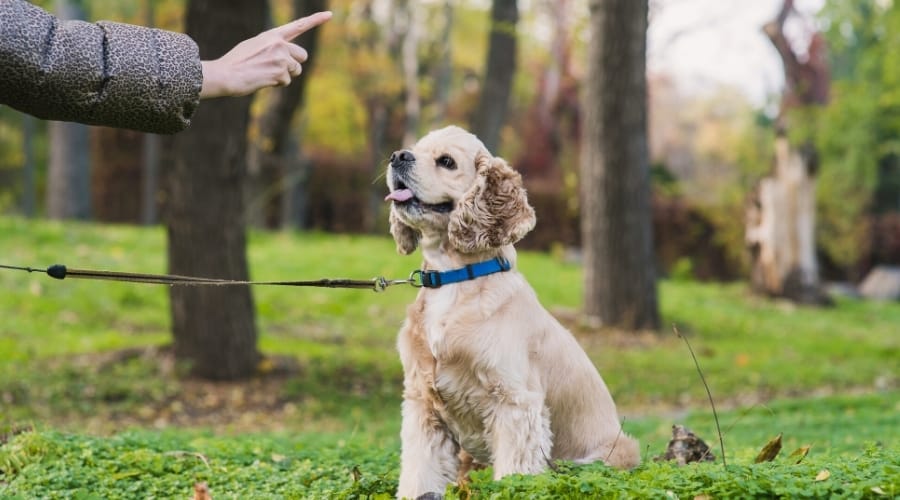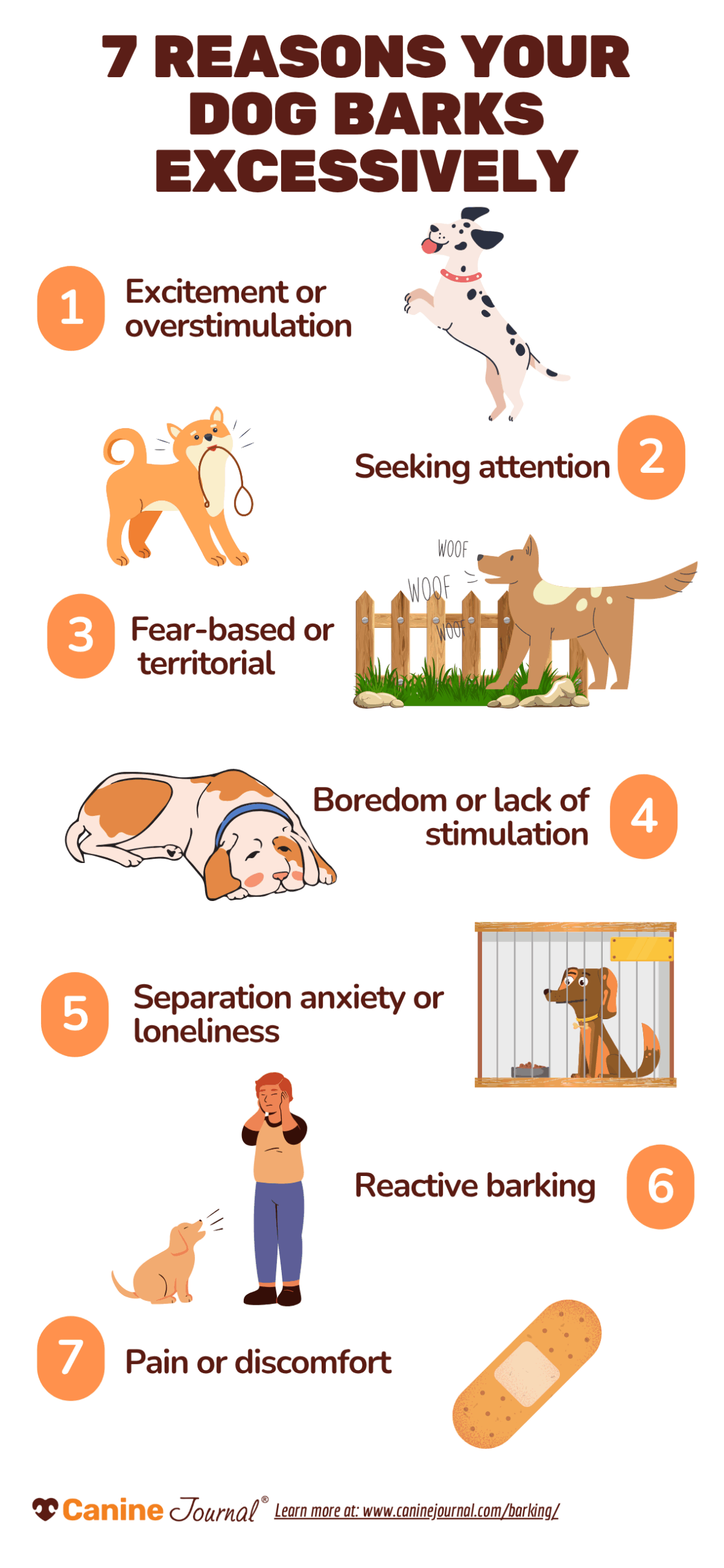Unlocking The Silence: Why Dogs Bark So Much & What You Can Do About It
When you purchase through links on our site, we may earn a commission. Here’s how it works.
You’re enjoying a quiet afternoon in the yard. Birds are chirping, the water feature is trickling, and everything feels peaceful… until Fido suddenly launches into full-volume barking at what seems like nothing at all.
Table of Contents
Or maybe you didn’t even make it that far because your dog barks at everything, all day long.
It’s exhausting and frustrating. I hear you — and your dog — and this guide will help you understand what’s really going on.

Why Dogs Bark: It’s Their Way of Talking
Let’s be clear: dogs are supposed to bark. It’s not just noise; it’s how they communicate. Whether they’re chatting with you or another pup down the street, barking is their version of speech (just with more woofs and fewer syllables).
But here’s the twist: Not all barks mean the same thing. Tone, pitch, frequency, and even the situation play into what your dog’s trying to say.
Some dogs are naturally louder. Some keep it low-key. Just like people, really.
Myth: Some Dogs Just Bark for No Reason
Truth: Every bark has a trigger, even if it’s subtle. Whether it’s boredom, anxiety, reactivity, or hidden pain, barking is your dog’s way of expressing a need or concern.
Should You Stop Barking Entirely?
Nope. And you shouldn’t try.
Imagine if someone told you to stop talking forever. Frustrating, right? That’s what it feels like when we try to silence our dogs completely.

The real goal?
- Stop the excessive, nonstop barking.
- Encourage the useful kind — like alerting you someone’s at the door or when it’s potty time.
Too much barking can strain your relationships with neighbors, lead to fines (yep, it happens), or even violate rental agreements.
Barking Has A Purpose
Dogs bark for reasons that actually help us:
- Letting you know someone’s on the property? Helpful.
- Barking to go outside before an accident? Also helpful.
What you don’t want? Constant, frantic barking at nothing. That’s when it becomes a problem.
Balance Is Everything
The trick isn’t silencing your dog. It’s understanding why they’re barking in the first place.
You can start steering them toward better habits once you figure out what they’re trying to say. Because, in the end, a well-timed bark can be a beautiful thing.
Tip: Teach Your Dog The “Quiet” Command
If your dog’s barking has gone from background noise to full-blown chaos, there’s good news: you can teach them to stop barking on cue. You don’t need special equipment or advanced skills — just consistency, timing, and the right approach.

Enter the “Quiet” command. This cue teaches your dog, “I hear you… and that’s enough.” When taught correctly, it’s surprisingly effective — even for dogs who seem hopelessly noisy.
How To Teach The Quiet Command
Most people are surprised to learn that you start by teaching your dog to bark on cue. Once they understand “Speak,” you can teach “Quiet” as the opposite behavior.
There are two simple steps:
Step 1: Teach “Speak”
- Capture the bark. When your dog naturally barks (often during play or excitement), mark it with “Yes!” and reward immediately.
- Repeat and reward. Do this several times so your dog learns that barking = treat.
- Add the cue. Once they’re offering the behavior consistently, say “Speak” just before they bark. Reward when they do.
Over time, your dog learns to bark on cue, which makes the next step much easier.
Step 2: Teach “Quiet”
- Ask your dog to Speak once or twice.
- As soon as there’s a pause in the barking, say “Quiet.”
- Immediately reward the silence — even if it’s only half a second at first.
- Continue asking for slightly longer quiet moments before rewarding.
- Once they understand both cues, mix them together (“Speak” → “Quiet”) to strengthen the contrast.
Dogs learn fastest when they’re confident and relaxed, so avoid scolding or using a harsh tone. You want “Quiet” to feel rewarding, not threatening.
Pro Tips For Success
- Reward fast. If you wait too long, your dog might think you’re rewarding barking — timing matters.
- Keep sessions short and upbeat. A few minutes at a time is plenty.
- Use high-value treats. Something special, like freeze-dried liver, keeps your dog motivated.
- My dogs go crazy for my DIY freeze-dried liver treats, and I share that recipe (plus more freeze-dried ideas) in our guide.
Train Early: 5 Ways to Prevent Excessive Barking From The Start
Do you have a puppy or a newly adopted dog? You’re in the sweet spot.
This time is your golden window to shape lifelong behavior, including how, when, and why your dog barks.

1. Start Early, Stay Sane Later
The earlier you introduce boundaries and expectations, the easier it is to prevent barking before it becomes a habit. It’s much simpler to guide a young dog than to unteach an older one.
2. Reward The Right Behavior
Here’s the secret: Only calm, relaxed behavior earns praise and treats. If you reward barking, even accidentally, you’re reinforcing it.
Don’t give in just because they’re cute. That adorable demand bark for attention or snacks? If it works once, they’ll try it again and again.
3. No Boundaries = Noisy Dog
Without clear limits, your dog may start thinking barking at every doorbell, squirrel, or leaf blowing in the wind is totally acceptable. Sound familiar?
4. Socialization Is Key
Early socialization does more than improve manners. It builds confidence. Expose your dog to:
- New people
- Different environments
- Noise (like vacuum cleaners or traffic)
- Everyday objects
The result? A more adaptable, less reactive dog — and far less barking.
5. What To Teach From Day One
Let your pup know:
- Barking to alert you is okay (within reason)
- Barking for attention every five minutes isn’t
Consistent training and clear communication are your best tools. When your dog knows the rules, they’re more secure and, usually, much quieter.
Myth: Bark Collars Are the Best Fix
Truth: Bark collars may suppress barking but rarely solve the root cause. Without addressing underlying triggers or teaching new behaviors, they often just silence the symptom, not the problem. Learn more about bark collars and how to use them in our detailed guide.
Top 7 Reasons Dogs Bark Excessively
Dogs can’t speak to us in our language. How easier would life be if they could?
Think of your dog as a newborn baby. Babies cry when hungry, want attention, are ill, or are scared.
Babies can’t tell their parents the problem; they can only make a noise. And for dogs, their noise is barking.
Let’s face it: dogs bark for all kinds of reasons. It’s not just random noise (even if it feels that way at 3 a.m.). If your dog’s barking has gone from cute to chaotic, it’s time to figure out what’s behind it.

Once you know the “why,” you can start tackling the “how” to stop it. Here are the 7 most common reasons dogs bark excessively, plus a peek at what each type of bark is trying to tell you.
1. Excitement Or Overstimulation
What this usually means: Your dog is happily anticipating something fun or is overwhelmed in a positive way.

Excited barking usually comes with a waggy tail and wiggly butt. Spinning in circles or tapping their paws are also signs of excitement. They look alert, generally pleased, with their ears held high.
Common examples include when you come home after work or say “walkies.” That Zoomies 2.0 barkfest when you grab the leash? Classic excitement barking.
This barking usually lasts a minute or two and stops once they get what they want. It’s normal and rarely a problem.
Signs
- Waggy tail, spinning, paw tapping
- Barking when you say “walk” or grab the leash
- Short bursts that stop once they get the reward
Action Steps
- Quick fix: Practice calm greetings. Ignore until they settle, then reward the calm.
- Try this: Teach a “sit and wait” before exciting events like grabbing the leash or opening the door.
2. Attention-Seeking Behavior
What this usually means: Your dog has learned that barking gets your attention — even if the attention is negative.

Attention barks are short, sharp, and monotone, often with pauses for you to respond. Their body language is relaxed, with a slow wagging or stiff tail. This often happens when your dog wants petting, playtime, or a bathroom break.
Typical Traits
- Short, monotone barks with pauses
- Relaxed body, slow wagging tail
- Happens when you’re busy or not engaging with them
Action Steps
If the barking signals a need (like going outside), respond. But if it’s for treats or entertainment, reacting reinforces the behavior. Even scolding can feel rewarding.
- Quick fix: Don’t reward the bark. No eye contact, talking, or reaction. Wait for silence before engaging.
- Try this: Teach an “all done” cue so they learn barking won’t restart play.
3. Separation Anxiety Or Loneliness
What this usually means: Barking starts because your dog is distressed, anxious, or overwhelmed when left alone.

This often begins as soon as you leave and may sound panicked, or it may include howling. It can last for long stretches. You may only learn about it from neighbors or indoor cameras.
Signs include trembling, pacing, droopy ears, and tense body language. Extremely anxious dogs may cycle between barking and howling.
Common Signs
- Barking the moment you leave
- Distressed tone or howling
- Trembling, pacing, uneasy posture
Action Steps
- Quick fix: Leave a puzzle feeder or frozen lick mat to keep them occupied when you leave.
- Try this: Practice short absences, slowly increasing time away.
4. Fear-based Or Territorial Barking
What this usually means: Your dog is warning about a perceived threat or reacting to something unfamiliar or unsettling.

Barking at mail carriers, passing cars, or strangers is classic territorial behavior. Your dog stands taller, tail raised, and may growl or bare teeth. Fear-based barking tends to sound deeper and continues until the trigger leaves.
Look For
- Barking at strangers, mail carriers, or cars
- Raised tail, stiff posture, growling, or showing teeth
- Barking that doesn’t stop until the person or noise leaves
Fearful dogs may lower their head, tuck their tail, or show raised hackles. Some combine growling and barking when unsure.
Action Steps
- Quick fix: Block their view of common triggers with curtains, window film, or repositioned furniture.
- Try this: Teach a “thank you” cue to acknowledge the alert, then redirect with a treat or task.
5. Boredom Or Lack Of Stimulation
What this usually means: Your dog isn’t getting enough mental or physical activity and uses barking to entertain themselves.

Bored dogs bark or howl out of frustration. It’s one of the most common barking types and can escalate into bigger behavioral issues if ignored.
You Might Notice
- Long stretches of barking or howling
- Play bows or carrying toys to you
- Short gruffs or howls to prompt interaction
Bringing a toy or doing a play bow is their version of saying, “I need something to do.”
Action Steps
- Quick fix: Rotate toys daily so old toys feel new again.
- Try this: Add a 10-minute sniff walk. Scent work is mentally stimulating and naturally calming.
6. Reactive Barking
What this usually means: Your dog is reacting to triggers — movement, noise, animals, or unfamiliar situations.

Reactive barking is a knee-jerk response often directed at passing dogs, bikes, vacuums, or loud sounds. It looks like fear or territorial barking, but it isn’t always rooted in anxiety or guarding behavior.
Common Signs
- Barking at dogs or people passing by
- Barking at vacuums, sirens, or sudden noises
- Barking that stops once the trigger is gone
Your dog may bark to investigate because they’re excited or because the movement feels like a game.
Action Steps
- Quick fix: Avoid stacking stressors. Choose a quiet walk or skip overstimulating situations on busy days.
- Try this: Use counter-conditioning. Offer treats when the trigger appears before barking starts.
7. Pain Or Discomfort
What this usually means: Sudden or sharp barking may be your dog’s way of saying something hurts.

Pain-based barking happens during movement, play, or impact and often sounds high-pitched or like a yelp. It usually stops after a few barks. Puppies frequently use this bark to tell playmates they’ve crossed a line.
You May Hear This
- During play, especially with puppies
- After bumping into something or being stepped on
- When a chronic condition flares up
Action Steps
- Quick fix: Watch for limping, licking a specific spot, or hiding.
- Try this: Contact your vet if the barking feels out of character or persists without a clear reason.
When Barking Spikes (Seasonal Triggers)
Barking often increases in winter, during holidays, and anytime your dog’s routine changes. Less sunlight, fewer walks, extra energy, new sounds, and constant door activity can all add up. Many dogs become more reactive when life gets busy or unpredictable.
If your dog gets noisier during these seasons, it’s often a response to the environment — not a permanent behavior shift.
Myth: Barking Isn’t About Dominance
Truth: The dominance theory is outdated and inaccurate in most barking cases. Modern research from the American Veterinary Society of Animal Behavior (AVSAB) points to fear, stress, and unmet needs, not pack leadership struggles, as the root of most problem barking.

5 Effective Ways To Correct Barking Habits
Now that you understand why your dog is barking, it is time to focus on what you can do to change the behavior.
If you have already started working on the Quiet command, you are off to a great start. The next step is matching the correction method to the barking you are dealing with.
Different triggers call for different strategies, and the most effective training plans address the root cause. Every method here is designed to reduce barking without creating fear or mistrust.
With consistency and patience, these habits can improve much faster than most people expect.
1. Boredom Barking: When Your Dog Cannot Handle Downtime
If your dog barks out of boredom, they likely need more physical and mental stimulation. Exercise, enrichment, and predictable routines make a noticeable difference.

What Helps
- Provide chew sticks, snuffle mats, and indestructible toys while you’re away.
- Rotate toys to make them feel new and interesting.
- Boost mental stimulation with brain games and interactive toys.
- Offer exercise before you leave, including walks and physical games.
If you are gone for long hours, your dog may need extra support. Options include working from home part of the week, asking a neighbor or friend to stop by, hiring a dog walker, or using doggy daycare. Bored dogs fill the time somehow, and barking is often the easiest outlet.
2.”Look At Me!” Barking: When Attention Becomes A Game
This correction method is simple in theory but challenging in practice. Attention, even negative attention, reinforces barking. Your dog learns that making noise gets a response.

What Helps
- Ignore barking completely until your dog is calm.
- The moment they stop, reward with praise, attention, or release from the crate.
- If boredom sets in during training, offer a toy to redirect their energy.
Consistency is the key. Quiet brings rewards. Barking brings nothing. Over time, your dog learns that silence is what gets your attention.
3. Reactive Barking: When Every Noise Sets Them Off
Reactive barking is triggered by specific stimuli such as movement, sound, or unfamiliar activity. You must identify the trigger before you can change the behavior.

What Helps
- Remove or block the trigger when possible. Curtains, window film, and blocking fence-line access are good starting points.
- Call your dog inside as soon as they begin barking. Timing is everything.
- For doorbells and visitors, aim for one bark to alert you, then quiet down so you can take over.
- Practice desensitization in short, predictable sessions.
Watch: How to stop your dog barking at the front door by desensitizing them.
4. Anxious & Alone: Barking From Missing You
This type of barking comes from distress rather than misbehavior. Puppies who are never given short periods alone often grow into adults who panic during separation.

What Helps
- Start early by practicing short absences of 10 to 15 minutes.
- Exercise your dog before you leave to reduce excess energy.
- Provide toys, lick mats, and enrichment to keep their minds occupied.
- Consider crate training if your dog feels safer in a structured, cozy space.
- Use midday support such as dog walkers or daycare.
- Play soft music or talk radio to create a familiar background sound.
If the barking continues, your dog may be dealing with true anxiety. A veterinarian or behaviorist can help create a structured plan.
5. Fear-Based Barking: What Your Dog’s Telling You (Without Words)
Fearful barking is a natural response. Punishment can worsen fear, so the goal is to change how your dog feels about the trigger.

What Helps
If your dog is scared of, say, the vacuum, leave it out in the room.
- Let your dog explore the object when it is turned off.
- Reward calm curiosity at every step.
- Later, turn it on without moving it, and reward again.
- Use the Quiet command to reinforce moments of calm.
- Create positive associations with treats, games, or praise.
Some fears never fully fade, just like people who remain uneasy about spiders or thunderstorms. If your dog cannot tolerate the trigger, avoid it when possible or work with a professional behaviorist for guided desensitization.
Our Personal Experience With (Mostly) Overcoming Excessive Barking
My dog Daisy is a reactive barker. As she has gotten older, she has developed dementia, which has only made the problem worse.
Her more significant triggers are the doorbell and when someone knocks on the door. She is also a fence sergeant and will bark fairly aggressively at anyone on the other side of the fence, even if she knows them.
Daisy is a very muscular Pitbull Labrador mix, weighs about 80 pounds, and looks more like a polar bear than a dog. Her intimidating appearance, coupled with the insane barking, undoubtedly gives her a reputation as an aggressive dog.
Despite having six-foot-tall wooden fencing, I have had issues with my neighbors over Daisy’s barking. One man, who has lived next door to me for almost a decade, stopped talking to me one day after she barked at him for mowing his lawn. He was very upset about it and said he hated going into his own backyard because of her barking.
Obviously, I had to address the issue right away. After consulting the vet, I started Daisy on medication to calm her down and help temper her anxiety. I also started exercising her very early in the morning to tire her out, and stayed outside with her when she was in the backyard.
When she barked at the neighbors, I would use the “leave it” command and give her a treat when she stopped barking and walked away. This multi-faceted approach helped quite a bit, but she still barks like a lunatic whenever anyone is at the front door.
– Danielle DeGroot, Rescue Dog Parent, Canine Journal Research & Writing
What NOT To Do When Your Dog Won’t Stop Barking
When your dog barks nonstop, and your patience is running on fumes, it’s tempting to try whatever gets them to be quiet. Even if it’s not exactly dog-trainer-approved. But here’s the thing: some common “solutions” actually make the barking worse.

Now that you know what to do with an excessive nuisance barker, here are the two things you need to avoid at all costs. Doing any of these things can worsen matters and cause even more barking. In addition to educating Fido, you need to educate yourself
1. Don’t Yell At Your Dog
This is the most common mistake that dog owners make when trying to stop excessive barking. You’d think that telling a dog off for barking would make them stop, but no. Fido’s brain isn’t wired like that.
Remember, your pup cannot understand what you are saying. And they think you’re shouting with them, leading them to believe their ‘shouting’ is acceptable.
Positive reinforcement training is much more effective at teaching better habits than punishment. So, ignore the barking and reward your dog when quiet and relaxed.
2. Don’t Accidentally Reward The Barking
Another mistake dog owners make is to praise their dogs for barking. This is a big no-no.
Petting your pooch to ‘calm them down’ is seen as praise to them. Yup, your pup thinks, “Oh, barking works! I’ll do it more!” It boosts their ego so that they can carry on barking.
Instead, reward only the moments when they’re quiet or calm, and ignore them when they bark. It may feel weird to totally ignore them mid-bark-fest, but trust me, silence is golden (and treat-worthy).
4 Extra Tips To Curb Persistent Barking
If you are still dealing with nonstop barking even after training and enrichment, you are not out of options. Some dogs need extra help or different approaches to break long-standing barking habits.

Here are four additional strategies that can support the training methods above. They can be used on their own or alongside the correction techniques you already started.
1. Use Familiar Sounds To Desensitize Your Dog
Dogs respond strongly to changes in their environment. Familiar, steady sounds can help reduce tension and prevent barking, especially when your home becomes quiet and feels “empty.”
What Helps
- Leave the radio or television on to create background noise.
- Use dog monitors such as Petcube and Furbo so you can check in or dispense treats.
- Only speak to your dog through the monitor when they are calm, so you do not reinforce barking.
If your dog reacts to specific noises such as doorbells or vacuums, sound desensitization can help.
How To Practice Sound Desensitization
- Play a recording of the trigger at a low volume.
- Reward your dog for staying calm.
- Gradually increase the volume as they become more comfortable.
This teaches your dog that these sounds are ordinary and do not require a barking response.
Watch: A perfect example of why early sound desensitization matters. This dpg was introduced to fireworks recordings as a puppy, always paired with treats and calm praise. Now real fireworks come and go, and he stays relaxed and unfazed.
2. Try Gentle Noise-Correction Techniques
Noise interruption is used when your dog completely ignores redirection attempts. The goal is not to scare your dog. It is simply to interrupt the bark pattern long enough for you to redirect the behavior.
What Helps
- Use an item that makes a brief, startling sound, such as a tin can with coins or a handheld horn.
- Rattle or activate it immediately when barking begins to interrupt the cycle.
- You can also try a sharp clap or a clear “shhh” sound.
- Once your dog pauses and looks at you, give the Quiet cue and reward the silence.
These techniques should be used sparingly. They can be helpful for some dogs, but the goal is distraction, not punishment.
Watch: An ultrasonic whistle can break the bark cycle and give you back some quiet. Ultrasonic whistles can grab a dog’s attention because dogs hear far higher frequencies than humans. Use responsibly and an always pair it with training and clear communication.
3. Consider An Anti-Bark Collar (As A Last Resort)
Some dog owners and trainers use anti-bark collars when other training methods are not successful. They can offer relief in specific situations but should never be the first choice as they do not address the underlying cause of barking.
There are three main types:
- Shock collars
- Citronella spray collars
- Sonic or ultrasonic collars
These devices activate when the dog barks. While they can interrupt the behavior, some dogs may become anxious when wearing them.
What Helps
- Always talk to your veterinarian or a certified trainer before using one.
- Pair the collar with training and behavior modification rather than relying on it alone.
Anti-bark collars can be helpful in certain dogs, but they are not a universal solution.
4. Call In The Experts
Some barking behavior is deeply rooted and requires professional support. A qualified trainer or behaviorist can identify patterns you may not notice and create a custom plan for your dog.
A Professional Can
- Spot subtle triggers that are easy to miss
- Build a personalized training strategy
- Help you feel more confident working with your dog
Reaching out for expert help is not a failure. It shows you are committed to improving your dog’s quality of life and your own. Many stubborn barking cases improve quickly once a specialist steps in.

Myth: Older Dogs Can’t Learn to Bark Less
Truth: Dogs of any age can learn new behaviors. With positive reinforcement and consistency, even senior dogs can adjust their barking habits and thrive with mental stimulation.
Frequently Asked Questions
If your dog’s barking feels endless or confusing, you’re definitely not alone. Below are answers to some of the most common questions dog owners ask about excessive, constant, or seemingly random barking.
If you don’t see yours, respond in the comments, and we’ll find the answer for you.
Why Is My Dog Constantly Barking?
If your dog is constantly barking, it’s usually their way of communicating something important. Common reasons include boredom, anxiety, excitement, or a response to outside triggers like people, animals, or unfamiliar sounds.
In many cases, dogs bark to get attention or to express that they need something, like food, a walk, or mental stimulation. Observing when and where the barking happens can help identify the cause, making it easier to address the behavior through training and routine changes.
What Causes Excessive Dog Barking?
Excessive barking in dogs is typically a sign that something is off in their environment or routine. It can stem from a lack of physical exercise, not enough mental stimulation, fear, separation anxiety, or even health-related discomfort.
Dogs may also bark excessively if they’ve learned that barking gets them what they want, whether that’s attention, food, or play. It’s important to first understand what’s triggering it to reduce excessive barking, then use positive reinforcement and training to redirect the behavior.
Is My Dog Barking For No Reason?
It might feel like your dog is barking for no reason, but there’s almost always a trigger, even if it’s something we humans can’t detect. Dogs have incredibly sensitive hearing and smell, and they often react to things we can’t see, like distant noises, unfamiliar scents, or subtle changes in their environment.
If barking seems random or frequent, try tracking the context and timing. This can help uncover a hidden pattern or consistent trigger that you can work on managing.
How Do I Stop My Dog From Barking Continuously?
If your dog is barking continuously, it’s important to respond calmly and consistently. Start by teaching the “quiet” command and reward your dog when they stop barking, even for a moment. Avoid yelling or giving attention during barking, as that can reinforce the behavior. Instead, redirect their energy with toys, exercise, or mental enrichment.
If the barking persists, rule out potential health issues with your vet. A combination of structure, patience, and positive reinforcement usually leads to lasting results.
Why Do Dogs Bark Constantly?
Dogs bark constantly when they’re trying to communicate something or when they’re experiencing emotional or physical discomfort. This behavior can result from boredom, loneliness, fear, anxiety, or excitement. In some cases, dogs bark out of habit because it has worked for them in the past.
To reduce constant barking, look at your dog’s daily routine, level of physical activity, and emotional well-being. Small changes like increased playtime, more consistent training, or calming routines can make a big difference.
Are Some Dog Breeds More Likely To Bark Excessively?
Absolutely. Some breeds are just born chatty. Breeds like Beagles, Chihuahuas, Yorkshire Terriers, Miniature Schnauzers, Dachshunds, and Huskies are naturally more vocal.
It’s not a flaw. Many of these dogs were originally bred to alert, herd, or guard, so barking was literally part of the job description.
If you’ve got a naturally vocal breed, it doesn’t mean barking is uncontrollable, but it does mean you’ll need:
- More structured training
- Extra mental and physical stimulation
- Realistic expectations
Understanding your dog’s breed tendencies helps you tailor your approach and set goals that actually make sense for your dog, not someone else’s golden retriever.
Bottom line: You can’t change a dog’s instincts, but you can teach them when it’s okay to speak and when it’s time to be quiet.
Other Ways To Improve Fido’s Behavior & Wellness
If barking is only one of the bad behaviors you’re working on, you’re in the right place. We break down how to curb chewing, digging, biting, and even poop-eating, with simple strategies that actually work.
Does your dog bark so much that you always have a headache? Have you tried our dog barking training tips above with success? We love to hear from our readers, so please respond in the comments section below.



